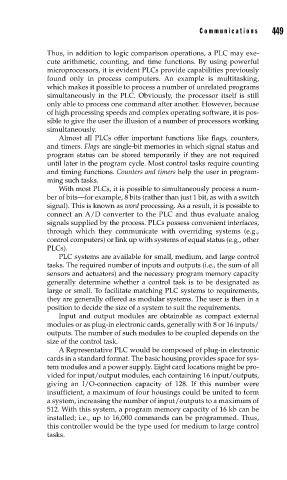Page 496 - Sensors and Control Systems in Manufacturing
P. 496
Communications
Thus, in addition to logic comparison operations, a PLC may exe- 449
cute arithmetic, counting, and time functions. By using powerful
microprocessors, it is evident PLCs provide capabilities previously
found only in process computers. An example is multitasking,
which makes it possible to process a number of unrelated programs
simultaneously in the PLC. Obviously, the processor itself is still
only able to process one command after another. However, because
of high processing speeds and complex operating software, it is pos-
sible to give the user the illusion of a number of processors working
simultaneously.
Almost all PLCs offer important functions like flags, counters,
and timers. Flags are single-bit memories in which signal status and
program status can be stored temporarily if they are not required
until later in the program cycle. Most control tasks require counting
and timing functions. Counters and timers help the user in program-
ming such tasks.
With most PLCs, it is possible to simultaneously process a num-
ber of bits—for example, 8 bits (rather than just 1 bit, as with a switch
signal). This is known as word processing. As a result, it is possible to
connect an A/D converter to the PLC and thus evaluate analog
signals supplied by the process. PLCs possess convenient interfaces,
through which they communicate with overriding systems (e.g.,
control computers) or link up with systems of equal status (e.g., other
PLCs).
PLC systems are available for small, medium, and large control
tasks. The required number of inputs and outputs (i.e., the sum of all
sensors and actuators) and the necessary program memory capacity
generally determine whether a control task is to be designated as
large or small. To facilitate matching PLC systems to requirements,
they are generally offered as modular systems. The user is then in a
position to decide the size of a system to suit the requirements.
Input and output modules are obtainable as compact external
modules or as plug-in electronic cards, generally with 8 or 16 inputs/
outputs. The number of such modules to be coupled depends on the
size of the control task.
A Representative PLC would be composed of plug-in electronic
cards in a standard format. The basic housing provides space for sys-
tem modules and a power supply. Eight card locations might be pro-
vided for input/output modules, each containing 16 input/outputs,
giving an I/O-connection capacity of 128. If this number were
insufficient, a maximum of four housings could be united to form
a system, increasing the number of input/outputs to a maximum of
512. With this system, a program memory capacity of 16 kb can be
installed; i.e., up to 16,000 commands can be programmed. Thus,
this controller would be the type used for medium to large control
tasks.

